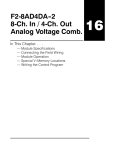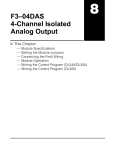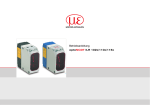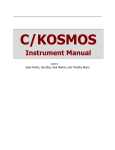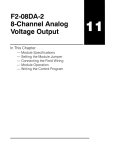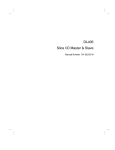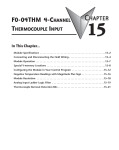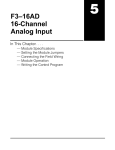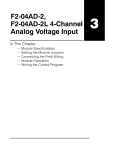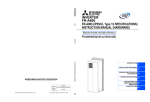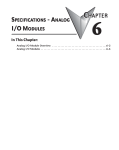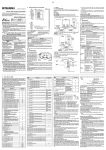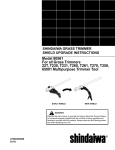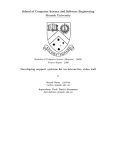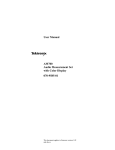Download F2-8AD4DA--1 8-Ch. In / 4-Ch. Out Analog Current Comb.
Transcript
F2-8AD4DA--1 8-Ch. In / 4-Ch. Out Analog Current Comb. In This Chapter. . . . — Module Specifications — Connecting the Field Wiring — Module Operation — Special V--Memory Locations — Writing the Control Program 15 15--2 F2-8AD4DA--1 8-Ch. In / 4-Ch. Out Analog Current Combination Module Specifications The F2-8AD4DA--1 Analog Current Input/Output module provides several hardware features: S Analog inputs and outputs are optically isolated from the PLC logic. S The module has a removable terminal block so the module can be easily removed or changed without disconnecting the wiring. S Updates all input and output channels in one scan. S On-board active analog filtering, two CISC microcontrollers, and CPLD provide digital signal processing to maintain precision analog measurements in noisy environments. S Low-power CMOS design requires only 100mA from an external 18--26.4 VDC power supply. S Input resolution is independently adjustable for each channel. Users may select 12 bit, 14 bit, or 16 bit. S Output resolution is 16 bit. S Broken transmitter detection bit (input < 2mA) for use with 4--20mA input device. S Each input can be independently configured to return the present value, or to track and hold the maximum or minimum value. S No jumper settings. F2-8AD4DA--1 8--Ch. In / 4 Ch. Out Hardware and Firmware Requirements IN / OUT ANALOG F2-8AD4DA--1 18-- 26.4VDC @100mA ANALOG 8 IN 0-- 20mA 4 OUT 4-- 20mA 0V OUT2 OUT3 0V IN2 IN3 0V IN6 IN7 24V OUT1 0V OUT4 IN1 0V IN4 IN5 0V IN8 F2-8AD4DA--1 The F2--8AD4DA--1 analog current input/output module requires one of the following components as a CPU or controller: Base Type CPU/Controller Firmware Version D2--250--1 4.40 or later D2--260 2.20 or later H2--WPLC pending Expansion D2--CM 1.30 or later Remote I/O H2--EBC(--F) 2.1.441 or later H2--EBC100 4.0.457 or later H2--PBC pending Local Profibus Slave DL205 Analog Manual 7th Ed. Rev. B 4/10 F2-8AD4DA--1 8-Ch. In / 4-Ch. Out Analog Current Combination 15--3 The following tables provide the specifications for the F2-8AD4DA--1 Analog Current Input/Output Module. Review these specifications to make sure the module meets your application requirements. Input Specifications Number of Input Channels 8, single ended (one common) Input Range 0 to 20mA Input Resolution / Value of LSB 12, 14, or 16 bit; selectable 12 bit, 0 to 20mA = 4.88A 14 bit, 0 to 20mA = 1.22A 16 bit, 0 to 20mA = 0.305A Input Impedance 100Ω ±0.1%, 1/4W Maximum Continuous Overload ±45mA Loop Supply Voltage Range 18 to 26.4VDC Filter Characteristics Active low pass; --3dB @ 80Hz PLC Input Update Rate 8 channels per scan (max. with pointers; local base) Sample Duration Time (note 1) 2ms @ 12bit; 5.52ms @ 14bit; 23ms @ 16bit Conversion Time (note 1) 12 bit = 1.5ms per channel 14 bit = 6ms per channel 16 bit = 25ms per channel Conversion Method Over sampling successive approximation Accuracy vs. temperature 25ppm/C max. Input Stability and Repeatability ±0.025% of range (after 30 minute warm--up) Input Inaccuracy 0.1% of range max. Linearity Error (end to end) 12 bit = ±2 count max. (±0.06% of range) 14 bit = ±10 count max. (±0.06% of range) 16 bit = ±40 count max. (±0.06% of range) Monotonic with no missing codes Full Scale Calibration Error ±0.07% of range max. (not including offset error) Offset Calibration Error ±0.03% of range max. Common Mode Rejection --90dB min. @ DC; --150dB min. @ 50/60Hz Crosstalk ±0.025% of range max. @ DC, 50/60Hz Recommended External Fuse 0.032A, Littelfuse series 217 fast-acting, current inputs Note 1: The values listed for Sample Duration Time and Conversion Time are for a single channel, and do not include PLC scan times. F2-8AD4DA--1 8--Ch. In / 4--Ch. Out DL205 Analog Manual 7th Ed. Rev. B 4/10 15--4 F2-8AD4DA--1 8-Ch. In / 4-Ch. Out Analog Current Combination Output Specifications Number of Output Channels 4 Output Range 4 to 20mA Output Resolution 16 bit; 0.244A/bit Output Type Current sourcing at 20mA max. Output Signal at Power--Up & Power--Down ≤4mA External Load Impedance 0--750Ω Maximum Inductive Load 1mH Allowed Load Type Grounded Output Voltage Drop 6V max.; 1V min. Max. Continuous Output Overload Open circuit protected Type of Output Protection Electronically current limited to 20mA or less PLC Output All Channel Update Time 4ms (local base) Output Settling Time 0 5ms max 0.5ms max.;; 5s min min. (full scale change) Output Ripple 0.005% of full scale Accuracy vs. Temperature ±25ppm/C max. full scale calibration change (±0.0025% of range / C) Output Stability and Repeatability ±1 LSB after 10 minute warm--up typical Output Inaccuracy 0.1% of range max. Linearity Error (end to end) ±33 count max. (±0.05% of full scale) Monotonic with no missing codes Full Scale Calibration Error ±0.07% of range max. (not including offset error) Offset Calibration Error ±0.03% of range max. Crosstalk at DC, 50/60Hz --70dB or 0.025% of full scale F2-8AD4DA--1 8--Ch. In / 4 Ch. Out One count in the specifications table is equal to one least significant bit of the analog data value (1 in 65536). DL205 Analog Manual 7th Ed. Rev. B 4/10 F2-8AD4DA--1 8-Ch. In / 4-Ch. Out Analog Current Combination General Module Specifications 15--5 Digital Input and Output Points Required 32 point (X) inputs 32 point (Y) outputs Power Budget Requirement 35mA @ 5VDC (supplied by base) External Power Supply Requirement 18 to 26.4VDC, 100mA maximum plus 20mA per output loop Field Side to Logic Side Isolation 1800VAC applied for 1 second (100% tested) Insulation Resistance >10M @ 500VDC Operating Temperature 0 to 60_C (32 to 140F); IEC60068--2--14 Storage Temperature --20 to 70_C (--4 to 158F); IEC60068--2--1, --2--2, --2--14 Relative Humidity 5 to 95% (non-condensing); IEC60068--2--30 Environmental Air No corrosive gases permitted; EN61131--2 pollution degree 1 Vibration MIL STD 810C 514.2; IEC60068--2--6 Shock MIL STD 810C 516.2; IEC60068--2--27 Noise Immunity NEMA ICS3--304; IEC61000--4--2, --4--3, --4--4 Emissions EN61000--6--4 (conducted and radiated RF emissions) Module Location Any non--CPU slot in local, expansion, or Ethernet remote base of DL205 system with DL250--1 or DL260 CPU Field Wiring 19 point removable terminal block included. Optional remote wiring using ZL--CM20 remote feed--through terminal block module and ZL--2CBL2# cable. Agency Approvals UL508; UL6079--15 Zone 2; CE (EN61131--2) Module Placement The F2-8AD4DA--1 analog current input/output module requires 32 discrete input and Configuration and 32 discrete output points. Requirements The module can be installed in any non--CPU slot of D2--250--1 or D2--260 local bases, D2--CM expansion bases, H2--EBC(100)(--F) Ethernet remote bases, H2--PBC Profibus slave bases, or H2--WPLCx--xx WinPLC bases. The module is NOT supported by D2--230, D2--240, or D2--250 CPUs. It is also not supported by D2--RMSM and D2--RSSS remote I/O master/slave modules. The available power budget may also be a limiting factor. Check the user manual for your particular model of CPU and I/O base for more information regarding power budget and number of local, local expansion, or Ethernet remote I/O points. F2-8AD4DA--1 8--Ch. In / 4--Ch. Out DL205 Analog Manual 7th Ed. Rev. B 4/10 15--6 F2-8AD4DA--1 8-Ch. In / 4-Ch. Out Analog Current Combination Connecting the Field Wiring Wiring Guidelines User Power Supply Requirements Your company may have guidelines for wiring and cable installation. If so, you should check those before you begin the installation. Here are some ideas to consider: S Use the shortest wiring route whenever possible. S Use shielded wiring and ground the shield at the signal source. Do not ground the shield at both the module and the load or source. S Do not run the signal wiring next to large motors, high current switches, or transformers. This may cause noise problems. S Route the wiring through an approved cable housing to minimize the risk of accidental damage. Check local and national codes to choose the correct method for your application. The F2-8AD4DA--1 requires at least one field-side power supply. You may use the same or separate power sources for the module supply and loop supply. The module requires 100mA at 18--26.4VDC. In addition, each current loop requires 20mA (a total of 240mA for twelve current loops). If you use a separate power supply, make sure that it meets these requirements. The DL205 bases have built-in 24VDC power supplies that provide up to 300mA of current. You may use this instead of a separate supply if you are using only one combination module with less than ten current loops. It is desirable in some situations to power the loops separately in a location remote from the PLC. This will work as long as the loop’s power supply meets the voltage and current requirements, and its minus (--) side and the module supply’s minus (--) side are connected together. WARNING: If you are using the 24VDC base power supply, make sure you calculate the power budget. Exceeding the power budget can cause unpredictable system operation that can lead to a risk of personal injury or damage to equipment. F2-8AD4DA--1 8--Ch. In / 4 Ch. Out The DL205 base has a switching type power supply. As a result of switching noise, you may notice ±3--5 counts of instability in the analog input data if you use the base power supply. If this is unacceptable, you should try one of the following: 1. Use a separate linear power supply. 2. Connect the 24VDC common to the frame ground, which is the screw terminal marked “G” on the base. By using these methods, the input stability is rated at ±0.025% of range. DL205 Analog Manual 7th Ed. Rev. B 4/10 15--7 F2-8AD4DA--1 8-Ch. In / 4-Ch. Out Analog Current Combination Current Loop Transmitter Impedance Standard 0 to 20mA and 4 to 20mA transmitters and transducers can operate from a wide variety of power supplies. Not all transmitters are alike and the manufacturers often specify a minimum loop or load resistance that must be used with the transmitter. The F2-8AD4DA--1 provides 100 Ohms resistance for each input channel. If your transmitter requires a load resistance below 100 Ohms, you do not have to make any adjustments. However, if your transmitter requires a load resistance higher than 100 Ohms, you need to add a resistor in series with the module. Consider the following example for a transmitter being operated from a 24VDC supply with a recommended load resistance of 750 Ohms. Since the module has only 100 Ohms resistance, you need to add an additional resistor. Example: R = Tr − Mr R = 750 − 100 R ≥ 650 R -- resistor to add Tr -- Transmitter total resistance requirement Mr -- Module resistance (internal 100 Ohms) Two-wire Transmitter + -DC Supply +24V 0V Module Channel 1 R IN1+ IN-- 100 Ohms In the example, add a 650 Ohm resistor (R) in series with the module. F2-8AD4DA--1 8--Ch. In / 4--Ch. Out DL205 Analog Manual 7th Ed. Rev. B 4/10 15--8 F2-8AD4DA--1 8-Ch. In / 4-Ch. Out Analog Current Combination Wiring Diagram The F2-8AD4DA--1 module has a removable connector to make wiring easier. Simply squeeze the top and bottom retaining clips and gently pull the connector from the module. Use the following diagram to connect the field wiring. The diagram shows one power supply for both the module and the I/O signal loops. If you want to use separate module and loop power supplies, connect the power supply 0V commons together. Internal module wiring + -+ -+ -+ -3--wire 4--20mA + transmitter 4--20mA output Channel 1 CH3 DAC CH4 DAC 100 See Note 2 4--20mA transmitter shield, Channel 3 See Note 1 0.032A 4--20mA transmitter shield, Channel 5 COM In3 COM 100 100 100 COM Transmitter power 100 In5 In8 AC or DC 4--wire 4--20mA transmitter CH2 DAC Out3 Out4 COM 4--20mA output Channel 4 See Note 2 CH1 DAC COM 4--20mA output Channel 3 100 100 100 CH1 ADC CH2 ADC Note 1: A Littelfuse Series 217, 0.032A fast--acting fuse is recommended for all 4--20mA current loop inputs. F2-8AD4DA--1 8--Ch. In / 4 Ch. Out Note 2: Connect shields to ground at their respective signal sources; do not ground both ends of shields. DL205 Analog Manual 7th Ed. Rev. B 4/10 F2-8AD4DA--1 18-- 26.4VDC @100mA ANALOG 8 IN 0-- 20mA 4 OUT 4-- 20mA 0V OUT2 CH3 ADC OUT3 CH4 ADC 0V CH5 ADC CH6 ADC IN2 IN3 0V CH7 ADC IN6 CH8 ADC IN7 4--20mA transmitter shield, Channel 8 See Note 2 ANALOG Isolated analog circuit power Out1 Out2 4--20mA output Channel 2 See Note 2 2--wire 4--20mA transmitter User 24VDC supply 24VDC+ 0VDC-- IN / OUT Isolated analog circuit common 24V OUT1 0V OUT4 IN1 0V IN4 IN5 0V IN8 F2-8AD4DA--1 8-Ch. In / 4-Ch. Out Analog Current Combination 15--9 Module Operation Input Channel Scanning Sequence (Pointer Method) If this module is installed in a local (CPU) base, you can obtain all eight channels of input data in one scan. However, you can obtain only one channel of input data per scan if the module is installed in an expansion, remote I/O, or Profibus slave base. System with analog module installed in local (CPU) base. Scan Read Inputs Execute Application Program Read the data Store data Write to Outputs Scan N Ch 1, 2, 3,... 7, 8 Scan N+1 Ch 1, 2, 3,... 7, 8 Scan N+2 Ch 1, 2, 3,... 7, 8 Scan N+6 Ch 1, 2, 3,... 7, 8 Scan N+7 Ch 1, 2, 3,... 7, 8 System with analog module installed in expansion, remote I/O or Profibus slave base. Scan Read Inputs Execute Application Program Read the data Store data Ch 1 Scan N+1 Ch 2 Scan N+2 Ch 3 Scan N+6 Ch 7 Scan N+7 Ch 8 DL205 Analog Manual 7th Ed. Rev. B 4/10 F2-8AD4DA--1 8--Ch. In / 4--Ch. Out Write to Outputs Scan N 15--10 F2-8AD4DA--1 8-Ch. In / 4-Ch. Out Analog Current Combination Output Channel Update Sequence (Pointer Method) If this module is installed in a local (CPU) base, you can update all four output channels in every scan. However, you can update only one channel of output data per scan if the module is installed in an expansion, remote I/O, or Profibus slave base. The timing is synchronized with the timing of reading the input channels, so you can update each output channel data every eight scans. System with analog module installed in local (CPU) base. Scan Read inputs Execute Application Program Calculate the data Write data Scan N Ch 1, 2, 3, 4 Scan N+1 Ch 1, 2, 3, 4 Scan N+2 Ch 1, 2, 3, 4 Scan N+3 Ch 1, 2, 3, 4 Scan N+4 Ch 1, 2, 3, 4 Write to outputs System with analog module installed in expansion, remote I/O or Profibus slave base. Scan Read Inputs F2-8AD4DA--1 8--Ch. In / 4 Ch. Out Execute Application Program Read the data Store data Write to Outputs Scan N Ch 1 Scan N+1 Ch 2 Scan N+2 Ch 3 Scan N+3 Ch 4 Scan N+6 Scan N+7 Scan N+8 DL205 Analog Manual 7th Ed. Rev. B 4/10 Ch 1 F2-8AD4DA--1 8-Ch. In / 4-Ch. Out Analog Current Combination Understanding the I/O Assignments 15--11 The F2-8AD4DA--1 module appears to the CPU as 32 discrete input and 32 discrete output points. These points provide the data value, channel identification, and settings for resolution, range, and track and hold feature. You may never have to use these bits, but it may help you understand the data format. Since all input and output points are automatically mapped into V-memory, it is very easy to determine the location of the data words that will be assigned to the module. F2-8AD4DA--1 Slot 0 Slot 1 Slot 2 Slot 3 Slot 4 8pt Input 8pt Input 16pt Output 32pt In 32pt Out 8pt Output X0 -X7 X10 -X17 Y0 -Y17 X20 Y20 --X57 Y57 V40500 V40400 MSB X 3 7 MSB X 5 7 V40401 Input Data Bits V40402 LSB X 2 0 LSB X 4 0 MSB Y 3 7 MSB Y 5 7 Y60 -Y67 V40503 V40501 Output Data Bits V40502 LSB Y 2 0 LSB Y 4 0 Within these memory word locations, the individual bits represent specific information about the analog signal. (Your specific memory locations may vary, depending upon the slot location of the F2--8AD4DA--1 module.) F2-8AD4DA--1 8--Ch. In / 4--Ch. Out DL205 Analog Manual 7th Ed. Rev. B 4/10 15--12 F2-8AD4DA--1 8-Ch. In / 4-Ch. Out Analog Current Combination Input Bits Depending upon the resolution selected, up to 16 bits of the first input word represent the analog data in binary format. Bit Value Bit Value 0 1 8 256 1 2 9 512 2 4 10 1024 3 8 11 2048 4 16 12 4096 5 32 13 8192 6 64 14 16384 7 128 15 32768 The upper byte of the second input word represents the broken transmitter detection bits for use only with 4--20mA input devices. The lower byte is not usable by the programmer. V40401 MSB X 5 6 -1 4 V40402 X 5 5 -1 3 X 5 4 -1 2 XX 55 32 -- -11 10 X 5 1 -9 F2-8AD4DA--1 8--Ch. In / 4 Ch. Out Output Bits 8 7 6 5 All 16 bits of the first output word represent the analog data in binary format. Bit Value Bit Value 0 1 8 256 1 2 9 512 2 4 10 1024 3 8 11 2048 4 16 12 4096 5 32 13 8192 6 64 14 16384 7 128 15 32768 The second output word is not usable by the programmer. DL205 Analog Manual 7th Ed. Rev. B 4/10 X 5 0 -8 X 4 7 -7 LSB X 4 6 -6 X 4 5 -5 X 4 4 -4 X 4 3 -3 X 4 2 -2 X 4 1 -1 X 4 0 -0 = broken transmitter bits = not usable by programmer Broken Transmitter Detection Bits (second input word) V40402 X X X X X X X Input Address # 57 56 55 54 53 52 51 Input Bit # 15 14 13 12 11 10 9 BT for Channel # X 2 0 -0 = data bits MSB X 5 7 -1 5 X 2 1 -1 X 2 2 -2 X 2 3 -3 X 2 4 -4 X 2 5 -5 X 2 6 -6 X 2 7 -7 X 3 0 -8 X 3 1 -9 XX 33 32 -- -11 10 X 3 4 -1 2 X 3 5 -1 3 X 3 6 -1 4 X 3 7 -1 5 LSB 4 3 Y 3 6 -1 4 Y 3 5 -1 3 Y 3 4 -1 2 YY 33 32 -- -11 10 Y 5 6 -1 4 Y 5 5 -1 3 X 40 ... 0 1 n/a ... n/a ... Y 3 1 -9 Y 3 0 -8 Y 2 7 -7 LSB Y 2 6 -6 Y 2 5 -5 Y 2 4 -4 Y 2 3 -3 Y 5 4 -1 2 YY 55 32 -- -11 10 Y 2 2 -2 Y 2 1 -1 Y 2 0 -0 = data bits V40502 MSB Y 5 7 -1 5 X 47 7 V40501 MSB Y 3 7 -1 5 2 X 50 8 Y 5 1 -9 Y 5 0 -8 Y 4 7 -7 Y 4 6 -6 LSB Y 4 5 -5 Y 4 4 -4 Y 4 3 -3 Y 4 2 -2 Y 4 1 -1 Y 4 0 -0 = not usable by programmer 15--13 F2-8AD4DA--1 8-Ch. In / 4-Ch. Out Analog Current Combination Special V--Memory Locations The DL250--1 and DL260 CPUs have special V--memory locations assigned to each base slot that greatly simplify the programming requirements. These V--memory locations specify: S the numbers of input and output channels to scan; S the storage locations for the input and output data; S the resolution selections for the inputs; S the range selections for the inputs and outputs; S the track and hold selections for the inputs. The tables below show the special V--memory used by the CPUs for the CPU base and local expansion base I/O slots. Slot 0 is the module slot next to the CPU or D2--CM module. Slot 1 is the module slot two places from the CPU or D2--CM, and so on. The CPU needs to examine the pointer values at these locations only after a mode transition. Module Configuration Registers CPU Base: Analog In/Out Module Slot-Dependent V-memory Locations Slot 0 1 2 3 4 5 6 7 No. of I/O Channels Enabled & Format V7660 V7661 V7662 V7663 V7664 V7665 V7666 V7667 Input Pointer V7670 V7671 V7672 V7673 V7674 V7675 V7676 V7677 Output Pointer V7700 V7701 V7702 V7703 V7704 V7705 V7706 V7707 Input Resolutions V36400 V36401 V36402 V36403 V36404 V36405 V36406 V36407 (Reserved) V36410 V36411 V36412 V36413 V36414 V36415 V36416 V36417 Input Track & Hold V36420 V36421 V36422 V36423 V36424 V36425 V36426 V36427 Expansion Base D2--CM #1: Analog In/Out Module Slot-Dependent V-memory Locations Slot 0 1 2 3 4 5 6 7 No. of I/O Channels V36000 V36001 V36002 V36003 V36004 V36005 V36006 V36007 Enabled & Format V36010 V36011 V36012 V36013 V36014 V36015 V36016 V36017 Output Pointer V36020 V36021 V36022 V36023 V36024 V36025 V36026 V36027 Input Resolutions V36030 V36031 V36032 V36033 V36034 V36035 V36036 V36037 (Reserved) V36040 V36041 V36042 V36043 V36044 V36045 V36046 V36047 Input Track & Hold V36050 V36051 V36052 V36053 V36054 V36055 V36056 V36057 DL205 Analog Manual 7th Ed. Rev. B 4/10 F2-8AD4DA--1 8--Ch. In / 4--Ch. Out Input Pointer 15--14 F2-8AD4DA--1 8-Ch. In / 4-Ch. Out Analog Current Combination Expansion Base D2--CM #2: Analog In/Out Module Slot-Dependent V-memory Locations Slot 0 1 2 3 4 5 6 7 No. of I/O Channels V36100 V36101 V36102 V36103 V36104 V36105 V36106 V36107 Enabled & Format Input Pointer V36110 V36111 V36112 V36113 V36114 V36115 V36116 V36117 Output Pointer V36120 V36121 V36122 V36123 V36124 V36125 V36126 V36127 Input Resolutions V36130 V36131 V36132 V36133 V36134 V36135 V36136 V36137 (Reserved) V36140 V36141 V36142 V36143 V36144 V36145 V36146 V36147 Input Track & Hold V36150 V36151 V36152 V36153 V36154 V36155 V36156 V36157 Expansion Base D2--CM #3: Analog In/Out Module Slot-Dependent V-memory Locations Slot 0 1 2 3 4 5 6 7 No. of I/O Channels V36200 V36201 V36202 V36203 V36204 V36205 V36206 V36207 Enabled & Format Input Pointer V36210 V36211 V36212 V36213 V36214 V36215 V36216 V36217 Output Pointer V36220 V36221 V36222 V36223 V36224 V36225 V36226 V36227 Input Resolutions V36230 V36231 V36232 V36233 V36234 V36235 V36236 V36237 (Reserved) V36240 V36241 V36242 V36243 V36244 V36245 V36246 V36247 Input Track & Hold V36250 V36251 V36252 V36253 V36254 V36255 V36256 V36257 Expansion Base D2--CM #4: Analog In/Out Module Slot-Dependent V-memory Locations Slot 0 1 2 3 4 5 6 7 F2-8AD4DA--1 8--Ch. In / 4 Ch. Out No. of I/O Channels V36300 V36301 V36302 V36303 V36304 V36305 V36306 V36307 Enabled & Format Input Pointer V36310 V36311 V36312 V36313 V36314 V36315 V36316 V36317 Output Pointer V36320 V36321 V36322 V36323 V36324 V36325 V36326 V36327 Input Resolutions V36330 V36331 V36332 V36333 V36334 V36335 V36336 V36337 (Reserved) V36340 V36341 V36342 V36343 V36344 V36345 V36346 V36347 Input Track & Hold V36350 V36351 V36352 V36353 V36354 V36355 V36356 V36357 Number of I/O Channels Enabled & Data Format Load this V--memory location with a constant that specifies the number of enabled I/O channels and their data formats. The upper byte applies to the inputs, and the lower byte applies to the outputs. The most significant nibbles specify the data formats, and the least significant nibbles specify the number of channels enabled. No. Channels Enabled 1 BCD Input K01xx K02xx K03xx K04xx K04xx K06xx K07xx K08xx Binary Input K81xx K82xx K83xx K84xx K85xx K86xx K87xx K88xx BCD Output Kxx01 Kxx02 Kxx03 Kxx04 n/a n/a n/a n/a Binary Output Kxx81 Kxx82 Kxx83 Kxx84 n/a n/a n/a n/a DL205 Analog Manual 7th Ed. Rev. B 4/10 2 3 4 5 6 7 8 15--15 F2-8AD4DA--1 8-Ch. In / 4-Ch. Out Analog Current Combination Input Resolution Selection Bits Each of the eight input channels can be individually disabled or configured for 12, 14, or 16 bit resolution. V36403: (specific memory location varies depending upon base and slot location) 15 14 13 12 11 10 9 8 7 6 5 4 3 2 1 0 R-- R-- R-- R-8H 8L 7H 7L R-- R-- R-- R-- R-- R-- R-- R-6H 6L 5H 5L 4H 4L 3H 3L R-- R-- R-- R-2H 2L 1H 1L RnH = Resolution channel n High bit RnL = Resolution channel n Low bit Input Resolution Select RnH RnL 12 bit 0 0 14 bit 0 1 16 bit 1 0 Disabled 1 1 Example: Input channels 1--4 are 12 bit, channel 5 is 14 bit, and channel 6 is 16 bit, and channels 7 and 8 are disabled; V36403 = F900(hex): 15 14 13 12 11 10 9 8 7 6 5 4 3 2 1 0 R-- R-- R-- R-8H 8L 7H 7L 1 1 1 1 R-- R-- R-- R-- R-- R-- R-- R-6H 6L 5H 5L 4H 4L 3H 3L 1 0 0 1 0 0 0 0 F 9 R-- R-- R-- R-2H 2L 1H 1L 0 0 0 0 0 0 The track and hold feature for each of the eight inputs can be individually configured Input Track and Hold Selection Bits for minimum, maximum, no hold, or reset held value. This configuration can be changed “on the fly” while the program is running. V36423: (specific memory location varies depending upon base and slot location) 15 14 13 12 11 10 9 8 7 6 5 4 3 2 1 0 T-- T-8H 8L T-- T-7H 7L T-- T-6H 6L T-- T-5H 5L T-- T-4H 4L T-- T-3H 3L T-- T-2H 2L T-- T-1H 1L TnH = Track and hold channel n High bit TnL = Track and hold channel n Low bit Track and Hold Select TnH TnL Result No Track and Hold 0 returns real time input value Track and Hold Minimum Value 0 1 maintains lowest measured value Track and Hold Max. Value 1 0 maintains highest measured value Reset Track and Hold Value 1 1 resets previously held input value Example: Input channel track and hold settings: ch 1--3 = none, ch 4--5 = minimum, ch 6--7 = maximum, ch 8 = reset; V36423 = E940(hex): 15 14 13 12 11 10 9 8 7 6 5 4 3 2 1 0 T-- T-8H 8L 1 1 T-- T-7H 7L 1 0 E T-- T-6H 6L 1 0 T-- T-5H 5L 0 1 9 T-- T-4H 4L 0 1 T-- T-3H 3L 0 0 4 T-- T-2H 2L 0 0 T-- T-1H 1L 0 0 0 DL205 Analog Manual 7th Ed. Rev. B 4/10 F2-8AD4DA--1 8--Ch. In / 4--Ch. Out 0 15--16 F2-8AD4DA--1 8-Ch. In / 4-Ch. Out Analog Current Combination Writing the Control Program Configuring the Module to Read / Write I/O (Pointer Method) 230 240 250-- 1 260 These example programs show how to configure the special V--memory locations to read/write data from/to the I/O module. The module configuration rung needs to be read by the CPU only after a mode transition, and does not need to be read every scan. Place the configuration rung anywhere in the ladder program, or in the initial stage if you are using stage programming instructions. This is all that is required to read the input data and write the output data to/from the V-memory locations. Once the input data is in V-memory, you can perform math on the data, compare the data against preset values, and so forth. F2-8AD4DA--1 8--Ch. In / 4 Ch. Out V2000 and V2020 are used as the beginning of the data areas in the example, but you can use any user V-memory locations. Also, these examples assume that the module is installed in slot 3 of the CPU base. You should use the pointer V-memory locations determined by the layout of your application. DL205 Analog Manual 7th Ed. Rev. B 4/10 F2-8AD4DA--1 8-Ch. In / 4-Ch. Out Analog Current Combination 15--17 Module Configuration Example 1: Number of Channels = 8 in, 4 out; Data Format = binary in, BCD out; Input Resolution = 16 bit; Input Track and Hold = none; real time value. SP0 LD K 8804 Loads a constant that specifies the number of channels to scan and the data format. (See note below regarding data format.) The upper byte applies to the inputs. The most significant nibble (MSN) selects the data format (0=BCD, 8=Binary), and the LSN selects the number of channels (1, 2, 3, 4, 5, 6, 7, or 8) to scan. The lower byte applies to the outputs. The most significant nibble (MSN) selects the data format (0=BCD, 8=Binary), and the LSN selects the number of channels (1, 2, 3, or 4) to scan. OUT V7663 LDA O2000 OUT V7673 LDA O2020 OUT V7703 LD KAAAA OUT V36403 LD K0 This constant designates the first V-memory location that will be used to store the input data. For example, the O2000 entered here would mean: Ch1 -- V2000, V2001; Ch2 -- V2002, V2003; Ch3 -V2004, V2005; Ch4 -- V2006, V2007; Ch5 -- V2010, V2011; Ch6 -V2012, V2013; Ch7 -- V2014, V2015; Ch8 -- V2016, V2017. For each channel, the 1st word holds the data, and the 2nd word is needed only when displaying 14 or 16 bit data in BCD format. The 2nd word contains the most significant digit in those cases. The constant O2000 is stored here. V7673 is assigned to slot 3 and acts as a pointer, which means the CPU will use the value in this location to determine exactly where to store the incoming data. This constant designates the first V-memory location that will be used for the analog output data. For example, the O2020 entered here would mean: Ch1 -- V2020, V2021; Ch2 -- V2022, V2023; Ch3 -V2024, V2025; Ch4 -- V2026, V2027. For each channel, the 1st word holds the data, and the 2nd word is needed only when displaying 14 or 16 bit data in BCD format. The 2nd word contains the most significant digit in those cases. The constant O2020 is stored here. V7703 is assigned to slot 3 and acts as a pointer, which means the CPU will use the value in this location to determine exactly where to obtain the output data. Loads a constant that specifies the resolutions for each of the input channels. This constant is determined by the values of two bits per channel, as shown previously in “Input Resolutions Selection Bits”. The constant AAAA(hex) configures each of the eight input channels for 16 bits. Special V--memory location assigned to slot 3 that contains the resolution settings for each of the input channels. Loads a constant that specifies the track and hold settings for each of the input channels. This constant is determined by the values of two bits per channel, as previously shown in “Track and Hold Selection Bits”. The constant 0 configures each of the eight input channels for no track and hold. Special V--memory location assigned to slot 3 that contains the track and hold settings for each of the input channels.. NOTE: Binary data format is recommended for 14 or 16 bit resolution input data, especially if the input data is to be used in any math instructions (DL205 User Manual, ch. 5). There is only one V--memory word (16 bits) available for the actual input data. Although the 12 bit resolution maximum value of 4095 can be stored in one word using either binary or BCD formats, the 14 and 16 bit resolution maximum values of 16383 and 65535 both exceed the BCD format’s maximum single word capacity of 9999. Double word math would be required for 14 or 16 bit data in BCD format. Binary data format is also useful for displaying data on some operator interfaces. DL205 Analog Manual 7th Ed. Rev. B 4/10 F2-8AD4DA--1 8--Ch. In / 4--Ch. Out OUT V36423 Special V-memory location assigned to slot 3 that contains the number of input and output channels. 15--18 F2-8AD4DA--1 8-Ch. In / 4-Ch. Out Analog Current Combination Module Configuration Example 2: Number of Channels = 4 in, 4 out; Data Format = binary in, BCD out; Input Resolution = 14 bit; Input Track and Hold = all inputs maximum value. SP0 LD K 8404 Loads a constant that specifies the number of channels to scan and the data format. (See note below regarding data format.) The upper byte applies to the inputs. The most significant nibble (MSN) selects the data format (0=BCD, 8=Binary), and the LSN selects the number of channels (1, 2, 3, 4, 5, 6, 7, or 8) to scan. The lower byte applies to the outputs. The most significant nibble (MSN) selects the data format (0=BCD, 8=Binary), and the LSN selects the number of channels (1, 2, 3, or 4) to scan. OUT V7663 LDA O2000 OUT V7673 LDA O2020 OUT V7703 LD K5555 OUT V36403 F2-8AD4DA--1 8--Ch. In / 4 Ch. Out LD KAAAA OUT V36423 NOTE: Special V-memory location assigned to slot 3 that contains the number of input and output channels. This constant designates the first V-memory location that will be used to store the input data. For example, the O2000 entered here would mean: Ch1 -- V2000, V2001; Ch2 -- V2002, V2003; Ch3 -V2004, V2005; Ch4 -- V2006, V2007. For each channel, the 1st word holds the data, and the 2nd word is needed only when displaying 14 or 16 bit data in BCD format. The 2nd word contains the most significant digit in those cases. The constant O2000 is stored here. V7673 is assigned to slot 3 and acts as a pointer, which means the CPU will use the value in this location to determine exactly where to store the incoming data. This constant designates the first V-memory location that will be used for the analog output data. For example, the O2020 entered here would mean: Ch1 -- V2020, V2021; Ch2 -- V2022, V2023; Ch3 -V2024, V2025; Ch4 -- V2026, V2027. For each channel, the 1st word holds the data, and the 2nd word is needed only when displaying 14 or 16 bit data in BCD format. The 2nd word contains the most significant digit in those cases. The constant O2020 is stored here. V7703 is assigned to slot 3 and acts as a pointer, which means the CPU will use the value in this location to determine exactly where to obtain the output data. Loads a constant that specifies the resolutions for each of the input channels. This constant is determined by the values of two bits per channel, as shown previously in “Input Resolutions Selection Bits”. The constant 5555(hex) configures each of the eight input channels for 14 bits. Special V--memory location assigned to slot 3 that contains the resolution settings for each of the input channels. Loads a constant that specifies the track and hold settings for each of the input channels. This constant is determined by the values of two bits per channel, as previously shown in “Track and Hold Selection Bits”. The constant AAAA(hex) configures each of the eight input channels to track and hold the maximum value. Special V--memory location assigned to slot 3 that contains the track and hold settings for each of the input channels.. Binary data format is recommended for 14 or 16 bit resolution input data, especially if the input data is to be used in any math instructions (DL205 User Manual, ch. 5). There is only one V--memory word (16 bits) available for the actual input data. Although the 12 bit resolution maximum value of 4095 can be stored in one word using either binary or BCD formats, the 14 and 16 bit resolution maximum values of 16383 and 65535 both exceed the BCD format’s maximum single word capacity of 9999. Double word math would be required for 14 or 16 bit data in BCD format. Binary data format is also useful for displaying data on some operator interfaces. DL205 Analog Manual 7th Ed. Rev. B 4/10 F2-8AD4DA--1 8-Ch. In / 4-Ch. Out Analog Current Combination 15--19 Module Configuration Example 3: Number of Channels = 4 in, 2 out; Data Format = BCD in, BCD out; Input Resolution = 12 bit; Input Track and Hold = all inputs minimum value. SP0 LD K 0402 Loads a constant that specifies the number of channels to scan and the data format. (See note below regarding data format.) (The leading zero in this LD instruction is shown for clarity. It can be entered by the programmer, but it will be dropped by the programming software.) The upper byte applies to the inputs. The most significant nibble (MSN) selects the data format (0=BCD, 8=Binary), and the LSN selects the number of channels (1, 2, 3, 4, 5, 6, 7, or 8) to scan. The lower byte applies to the outputs. The most significant nibble (MSN) selects the data format (0=BCD, 8=Binary), and the LSN selects the number of channels (1, 2, 3, or 4) to scan. OUT V7663 LDA O2000 OUT V7673 LDA O2020 OUT V7703 LD K0 OUT V36403 LD K5555 This constant designates the first V-memory location that will be used to store the input data. For example, the O2000 entered here would mean: Ch1 -- V2000, V2001; Ch2 -- V2002, V2003; Ch3 -V2004, V2005; Ch4 -- V2006, V2007. For each channel, the 1st word holds the data, and the 2nd word is needed only when displaying 14 or 16 bit data in BCD format. The 2nd word contains the most significant digit in those cases. The constant O2000 is stored here. V7673 is assigned to slot 3 and acts as a pointer, which means the CPU will use the value in this location to determine exactly where to store the incoming data. This constant designates the first V-memory location that will be used for the analog output data. For example, the O2020 entered here would mean: Ch1 -- V2020, V2021; Ch2 -- V2022, V2023. For each channel, the 1st word holds the data, and the 2nd word is needed only when displaying 14 or 16 bit data in BCD format. The 2nd word contains the most significant digit in those cases. The constant O2020 is stored here. V7703 is assigned to slot 3 and acts as a pointer, which means the CPU will use the value in this location to determine exactly where to obtain the output data. Loads a constant that specifies the resolutions for each of the input channels. This constant is determined by the values of two bits per channel, as shown previously in “Input Resolutions Selection Bits”. The constant 0 configures each of the eight input channels for 12 bits. Special V--memory location assigned to slot 3 that contains the resolution settings for each of the input channels. Loads a constant that specifies the track and hold settings for each of the input channels. This constant is determined by the values of two bits per channel, as previously shown in “Track and Hold Selection Bits”. The constant 5555(hex) configures each of the eight input channels to track and hold the minimum value. Special V--memory location assigned to slot 3 that contains the track and hold settings for each of the input channels.. NOTE: Binary data format is recommended for 14 or 16 bit resolution input data, especially if the input data is to be used in any math instructions (DL205 User Manual, ch. 5). There is only one V--memory word (16 bits) available for the actual input data. Although the 12 bit resolution maximum value of 4095 can be stored in one word using either binary or BCD formats, the 14 and 16 bit resolution maximum values of 16383 and 65535 both exceed the BCD format’s maximum single word capacity of 9999. Double word math would be required for 14 or 16 bit data in BCD format. Binary data format is also useful for displaying data on some operator interfaces. DL205 Analog Manual 7th Ed. Rev. B 4/10 F2-8AD4DA--1 8--Ch. In / 4--Ch. Out OUT V36423 Special V-memory location assigned to slot 3 that contains the number of input and output channels. 15--20 F2-8AD4DA--1 8-Ch. In / 4-Ch. Out Analog Current Combination Module 12 Bit Input Resolution When the module 0--20mA inputs are configured for 12 bit resolution, the analog signal is converted into 4096 (212) counts ranging from 0 -- 4095. For example, a 0mA signal would be 0, and a 20mA signal would be 4095. This is equivalent to a binary value of 0000 0000 0000 to 1111 1111 1111, or 000 to FFF hexadecimal. The diagram shows how this relates to the signal range. Each count can also be expressed in terms of the signal level by using the equation shown. Module 14 Bit Input Resolution When the module 0--20mA inputs are configured for 14 bit resolution, the analog signal is converted into 16384 (214) counts ranging from 0 -- 16383. For example, a 0mA signal would be 0, and a 20mA signal would be 16383. This is equivalent to a binary value of 00 0000 0000 0000 to 11 1111 1111 1111, or 0000 to 3FFF hexadecimal. The diagram shows how this relates to the signal range. Each count can also be expressed in terms of the signal level by using the equation shown. F2-8AD4DA--1 8--Ch. In / 4 Ch. Out Module 16 Bit Input Resolution When the module 0--20mA inputs are configured for 16 bit resolution, the analog signal is converted into 65536 (216) counts ranging from 0 -- 65535. For example, a 0mA signal would be 0, and a 20mA signal would be 65535. This is equivalent to a binary value of 0000 0000 0000 0000 to 1111 1111 1111 1111, or 0000 to FFFF hexadecimal. The diagram shows how this relates to the signal range. Each count can also be expressed in terms of the signal level by using the equation shown. DL205 Analog Manual 7th Ed. Rev. B 4/10 0 -- 20mA 12 Bit Resolution 20mA 0mA 0 4095 12 Bit Resolution = H − L 4095 H = high limit of the signal range L = low limit of the signal range 20mA / 4095 = 4.88A per count 0 -- 20mA 14 Bit Resolution 20mA 0mA 0 16383 14 Bit Resolution = H − L 16383 H = high limit of the signal range L = low limit of the signal range 20mA / 16383 = 1.22A per count 0 -- 20mA 16 Bit Input Resolution 20mA 0mA 0 65535 16 Bit Resolution = H − L 65535 H = high limit of the signal range L = low limit of the signal range 20mA / 65535 = 0.305A per count F2-8AD4DA--1 8-Ch. In / 4-Ch. Out Analog Current Combination 15--21 Analog and Digital Sometimes it is useful to be able to quickly convert between the signal levels and the digital values. This is especially helpful during machine startup or Input Data Value troubleshooting. The table provides formulas to make this conversion easier. Conversion A = (D)(Amax) / (Dmax) D = (A)(Dmax) / (Amax) S A = Analog value from current transmitter S Amax = Maximum analog value S D = Digital value of input provided to PLC CPU S Dmax = Maximum digital value Resolution X--mitter Range If you know the digital value... If you know the analog signal level... 12 bit 0--4095 0--20mA 4--20mA A = (D)(20) / 4095 D = (A)(4095) / 20 14 bit 0--16383 0--20mA 4--20mA A = (D)(20) / 16383 D = (A)(16383) / 20 16 bit 0--65535 0--20mA 4--20mA A = (D)(20) / 65535 D = (A)(65535) / 20 For example, if you are using 16 bit resolution, and have measured the signal at 12mA, you could use the formula to easily determine the digital value (D) that should be stored in the V-memory location that contains the data. D = (A) 65535 20 D = (12) (3276.75) D = 39321 Notice that the mathematical relationship between the analog and digital values remains the same regardless of whether 4--20mA or 0--20mA transmitters are used. Only the engineering unit input scaling will vary, as shown later. Input Value Comparisons: Analog, Digital, Engineering Units The following table shows how the input analog, digital, and engineering unit values are related to each other. The example is a measurement of pressure from 0.0 to 140.0 PSI, using a multiplier of 10 for one implied decimal place. Analog (mA) Digital 12 Bit Digital 14 Bit Digital 16 Bit E.U. 0--20mA Transmitter E.U. 4--20mA Transmitter 20 4095 16383 65535 1400 1400 12 2457 9830 39321 840 700 10 2048 8192 32768 700 525 4 819 3277 13107 280 0 0 0 0 0 0 N/A F2-8AD4DA--1 8--Ch. In / 4--Ch. Out DL205 Analog Manual 7th Ed. Rev. B 4/10 15--22 F2-8AD4DA--1 8-Ch. In / 4-Ch. Out Analog Current Combination Scaling the Input Data Most applications require measurements in engineering units, which provide more meaningful data. This can be accomplished by using the conversion formulas shown below: EU = (A -- Aoffset)(EUH -- EUL) / (Amax -- Aoffset) EU = (D -- Doffset)(EUH -- EUL) / (Dmax -- Doffset) S A = analog value from current transmitter S Aoffset = 4mA offset when using 4--20mA current transmitter S D = digital value of input provided to PLC CPU S Doffset = digital value of 4mA offset with 4--20mA current transmitter S EU = engineering units S EUH = engineering units high value S EUL = engineering units low value The following examples show a 16 bit measurement of pressure (PSI) from 0.0 to 140.0. You need to multiply the analog value by 10 in order to imply a decimal place when you view the value with the programming software or a handheld programmer. Notice how the calculations differ when you use the multiplier. Analog Value of 12.6mA, 4--20mA transmitter, 16 bit resolution, should yield 75.2 PSI Example without multiplier EU = (D − Doffset) Example with multiplier EU H − EU L D max − D offset EU = (41287 − 13107) 140 − 0 65535 − 13107 EU = 75 EU = (10)(D − Doffset) EU H − EU L D max − D offset EU = (10)(41287 − 13107) 140 − 0 65535 − 13107 EU = 752 Handheld Display Handheld Display V 2001 V 2000 0000 0075 V 2001 V 2000 0000 0752 This value is more accurate F2-8AD4DA--1 8--Ch. In / 4 Ch. Out NOTE: Binary data format is recommended for 14 or 16 bit resolution input data, especially if the input data is to be used in any math instructions (DL205 User Manual, ch. 5). There is only one V--memory word (16 bits) available for the actual input data. Although the 12 bit resolution maximum value of 4095 can be stored in one word using either binary or BCD formats, the 14 and 16 bit resolution maximum values of 16383 and 65535 both exceed the BCD format’s maximum single word capacity of 9999. Double word math would be required for 14 or 16 bit data in BCD format. Binary data format is also useful for displaying data on some operator interfaces. DL205 Analog Manual 7th Ed. Rev. B 4/10 F2-8AD4DA--1 8-Ch. In / 4-Ch. Out Analog Current Combination 15--23 Input Engineering Unit Conversion Example 1: Data Format = BCD; Channel 1 data memory location = V2000; Channel 1 resolution = 12 bits; Channel 1 engineering units = 0.0 to 140.0psi; Channel 1 input device = 0 to 20mA transmitter. Note, this example uses SP1 (which is always on) as a permissive contact for the engineering unit conversion. You could also use an X, C, etc. permissive contact. SP1 LD V2000 Load input channel 1 digital value into accumulator. MUL K1400 Multiply by 1400; EU range X 10 for implied decimal. DIV K4095 Divide by 4095; 12 bit digital range for 0--20mA. OUT V2100 Store input EU value in V2100. Input Engineering Unit Conversion Example 2: Data Format = binary; Channel 1 data memory location = V2000; Channel 1 resolution = 14 bits; Channel 1 engineering units = 0.0 to 140.0psi; Channel 1 input device = 0 to 20mA transmitter. Note, this example uses SP1 (which is always on) as a permissive contact for the engineering unit conversion. You could also use an X, C, etc. permissive contact. SP1 LD V2000 Load input channel 1 digital value into accumulator. MULB K578 Multiply by 1400 [hex 578]; EU range X 10 for implied decimal. DIVB K3FFF Divide by 16383 [hex 3FFF]; 14 bit digital range for 0--20mA. (Use 65535 [KFFFF] for 16 bit; 4095 [KFFF] for 12 bit.) OUT V2100 Store input EU value in V2100. F2-8AD4DA--1 8--Ch. In / 4--Ch. Out DL205 Analog Manual 7th Ed. Rev. B 4/10 15--24 F2-8AD4DA--1 8-Ch. In / 4-Ch. Out Analog Current Combination Input Engineering Unit Conversion Example 3: Data Format = BCD; Channel 1 data memory location = V2000; Channel 1 resolution = 12 bits; Channel 1 engineering units = 0.0 to 140.0psi; Channel 1 input device = 4 to 20mA transmitter. SP0 V2000 LD K819 Load constant 819 into accumulator; 12 bit digital value for 4mA offset. OUT V2030 Store input offset value in V2030. K819 C0 OUT C0 LD V2000 Load input channel 1 digital value into accumulator. (If input not less than 4mA.) SUB V2030 Subtract 819; 12 bit digital value for 4mA offset. (This rung not used if input transmitter is 0--20mA.) MUL K1400 Multiply by 1400; EU range X 10 for implied decimal. DIV K3276 Divide by 3276; 12 bit digital range for 4--20mA. (For 0--20mA xmitter: use 4095.) OUT V2100 Store input EU value in V2100. LD K0 Load value of 0 into accumulator. (If input less than 4mA.) (This rung not used if input transmitter is 0--20mA.) OUT V2100 Store value of 0 in V2100 (This rung not used if input transmitter is 0--20mA.) F2-8AD4DA--1 8--Ch. In / 4 Ch. Out C0 C0 is on when analog input is less than 4mA; 819 = 4mA @ 12 bits. (This rung not used if input transmitter is 0--20mA.) DL205 Analog Manual 7th Ed. Rev. B 4/10 F2-8AD4DA--1 8-Ch. In / 4-Ch. Out Analog Current Combination 15--25 Input Engineering Unit Conversion Example 4: Data Format = binary; Channel 1 data memory location = V2000; Channel 1 resolution = 16 bits; Channel 1 engineering units = 0.0 to 140.0psi; Channel 1 input device = 4 to 20mA transmitter. V2000 K3333 C0 OUT C0 C0 Using the Input Track and Hold Feature C0 is on when analog input is less than 4mA; 3333 hex = 13107 = 4mA @ 16 bits. (Use KCCD for 14 bit; K333 for 12 bit.) (This rung not used if input transmitter is 0--20mA.) LD V2000 Load input channel 1 digital value into accumulator. (If input not less than 4mA.) BTOR Convert from binary to real data format. SUBR R13107 Subtract 13107; 16 bit digital value for 4mA offset. (Use R3277 for 14 bit; R819 for 12 bit.) (This rung not used if input transmitter is 0--20mA.) MULR R1400 Multiply by 1400; EU range X 10 for implied decimal. DIVR R52428 Divide by 5248; 16 bit digital range for 4--20mA. (Use R13106 for 14 bit; R3276 for 12 bit.) (For 0--20mA xmitter: use 16 bit R65535, 14 bit R16383, 12 bit R4095.) RTOB Convert to binary data format. OUT V2100 Store input EU value in V2100. LD K0 Load value of 0 into accumulator. (If input less than 4mA.) (This rung not used if input transmitter is 0--20mA.) OUT V2100 Store value of 0 in V2100 (This rung not used if input transmitter is 0--20mA.) To Reset Track and Hold, write a value of one to the Track and Hold selection high and low bits. When Track and Hold is Reset, the module will display the real--time input value. When the selection is changed from Reset to Minimum Value or Maximum Value, the input will start over as described previously. DL205 Analog Manual 7th Ed. Rev. B 4/10 F2-8AD4DA--1 8--Ch. In / 4--Ch. Out The input Track and Hold feature allows the individual inputs to be separately configured to maintain their maximum or minimum data values. If No Track and Hold is selected, the present real time value of the input will be stored in the input data V--memory location. If Track and Hold Minimum Value is selected, the first input value less than or equal to full scale will be read and maintained until a lower value is measured, or until Track and Hold is Reset. If Maximum Value is selected, the first input value greater than or equal to zero will be read and maintained until a higher value is measured, or until Track and Hold is Reset. 15--26 F2-8AD4DA--1 8-Ch. In / 4-Ch. Out Analog Current Combination Track and Hold Example: Number of Channels = 1 in, 1 out; Data Format = binary in, binary out; Input Resolution = 16 bit; Input Track and Hold = channel 1 reset. SP0 LD K 8181 OUT V7663 LDA O2000 Rung 1, Module Configuration: Input: binary data format, 1 channel. Output: binary data format, 1 channel. Module location: local base, slot 3. Input data 1st memory location: V2000 Output data 1st memory location: V2020 Input resolution: 16 bit channel 1. Input Track and Hold: reset channel 1. OUT V7673 LDA O2020 OUT V7703 LD K2 OUT V36403 LD K3 OUT V36423 C1 LD K2 OUT V36423 C3 LD K3 OUT V36423 F2-8AD4DA--1 8--Ch. In / 4 Ch. Out C5 LD K1 OUT V36423 DL205 Analog Manual 7th Ed. Rev. B 4/10 C1 loads value of 2 (binary 10) into the Track and Hold Selection register. This sets input channel 1 for Track and Hold Maximum Value. As the analog value varies, only a measured value higher than the previously stored value will be written to V2000. C3 loads a value of 3 (binary 11) into the Track and Hold Selection register. This sets input channel 1 for Track and Hold Reset Value. Real--time measured values will be written to V2000 until another Track and Hold Selection is made. C5 loads value of 1 (binary 01) into the Track and Hold Selection register. This sets input channel 1 for Track and Hold Minimum Value. As the analog value varies, only a measured value lower than the previously stored stored will be written to V2000. F2-8AD4DA--1 8-Ch. In / 4-Ch. Out Analog Current Combination Module 16 Bit Output Resolution Since the 4--20mA output module has 16 bit resolution, the analog signal is converted into 65536 (216) counts ranging from 0 -- 65535. For example, a 4mA signal would be 0, and a 20mA signal would be 65535. This is equivalent to a binary value of 0000 0000 0000 0000 to 1111 1111 1111 1111, or 0000 to FFFF hexadecimal. The diagram shows how this relates to the signal range. Each count can also be expressed in terms of the signal level by using the equation shown. 4 -- 20mA 15--27 16 Bit Output Resolution 20mA 4mA 0 65535 Resolution = H − L 65535 H = high limit of the signal range L = low limit of the signal range 16mA / 65535 = 0.244A per count Digital and Analog Sometimes it is useful to be able to quickly convert between the signal levels and Output Data Value the digital values. This is especially helpful during machine startup or troubleshooting. The table provides formulas to make this conversion easier. Conversion A = Amin + [(D)(Amax --Amin) / (Dmax)] D = (A--Amin)(Dmax) / (Amax --Amin) S A = Analog current output value S Amax = Maximum analog value S Amin = Minimum analog value S D = Digital value from PLC CPU S Dmax = Maximum digital value Resolution Output Range If you know the digital value... If you know the analog signal level... 16 bit 0--65535 4--20mA A = 4 + [(D)(16) / 65535] D = (A-- 4)(65535) / 16 For example, if you need to produce an analog output signal of 10mA, you could use the formula to easily determine the digital value (D) that should be stored in the V-memory location that contains the data for output. Output Value Comparisons: Analog, Digital, Engineering Units D = (10 − 4) 65535 16 D = (6)(4095.94) D = 24576 The following table shows how the input analog, digital, and engineering unit values are related to each other. The example is a measurement of pressure from 0.0 to 140.0 PSI, using a multiplier of 10 for one implied decimal place. Digital 16 Bit E.U. 20 65535 1400 12 32768 700 10 24576 525 4 0 0 F2-8AD4DA--1 8--Ch. In / 4--Ch. Out Analog (mA) DL205 Analog Manual 7th Ed. Rev. B 4/10 15--28 F2-8AD4DA--1 8-Ch. In / 4-Ch. Out Analog Current Combination Calculating the Digital Output Value Your program must calculate the digital value to send to the 16 bit analog output module. There are many ways to do this, but most applications are understood more easily if you use measurements in engineering units. This is accomplished by using the conversion formula shown. You may have to make adjustments to the formula depending on the scale you choose for the engineering units. D = EU D max EU H − EU L D = digital value EU = engineering units EUH = engineering unit range high limit EUL = engineering unit range low limit Consider the following example which controls pressure from 0.0 to 140.0 PSI. By using the formula, you can determine the digital value that should be sent to the module. The example shows the conversion required to yield 52.5 PSI. Notice the formula divides by 10, because the BCD representation of 52.5 includes a multiplier of 10 to allow for the implied decimal. The division corrects for the multiplier. D = 10EU Calculating Output Data; Engineering Units Conversion D max 10(EU H − EU L) D = 525 65535 10(140) D = 24576 The example program shows how you would write the program to perform the engineering unit conversion to output 16 bit data format 0 -- 65535. This example assumes you have calculated or loaded the engineering unit values, including a multiplier of 10, in BCD format and stored it in V2120 for output channel 1. Output Engineering Unit Conversion / Output Data Calculation Example: Data Format = binary; Channel 1 data memory location = V2020; Channel 1 engineering units = 0 to 140psi. Note, this example uses SP1 (which is always on) as a permissive contact for the engineering unit conversion. You could also use an X, C, etc. permissive contact. F2-8AD4DA--1 8--Ch. In / 4 Ch. Out SP1 LD V2120 Load output channel data value into accumulator; BCD EU value X 10 for implied decimal. BIN Convert from BCD to binary data format. MULB KFFFF Multiply by 65535; FFFF hex = 65535; 16 bit maximum digital value. DIVB K578 Divide by 1400; 578 hex = 1400; EU range X 10 for implied decimal. OUT V2020 Store output digital value in V2020. DL205 Analog Manual 7th Ed. Rev. B 4/10




























